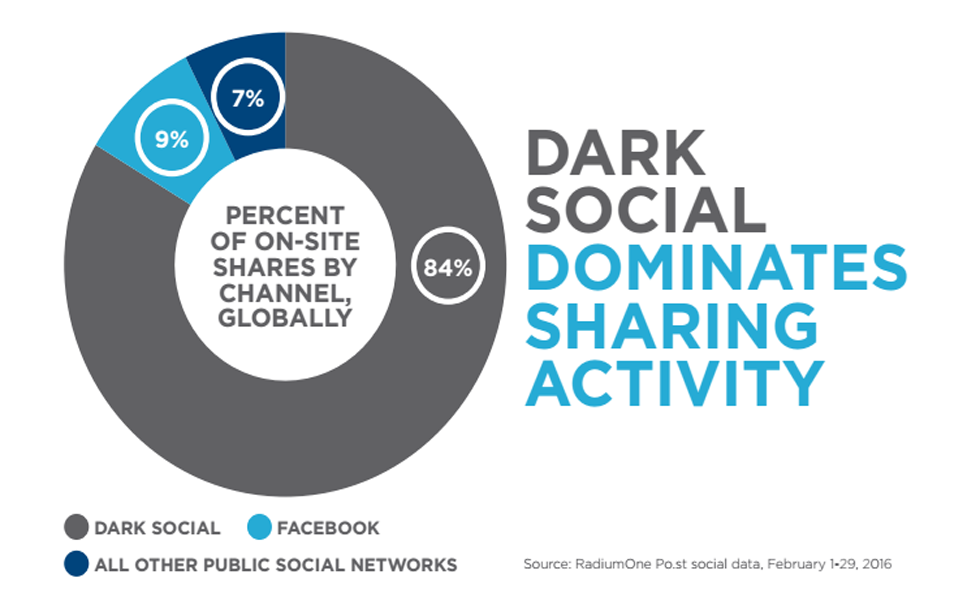 Dark social is an increasingly important source of referral traffic. According to new research from RadiumOne, dark social dominates how people share and interact with online content on smartphones.
Dark social is an increasingly important source of referral traffic. According to new research from RadiumOne, dark social dominates how people share and interact with online content on smartphones.
Its research found that dark social channels account for 77% of shared content via mobile phones, with just 23% coming from public social networks. And when it comes to engaging with shared content, 80% of clicks come from dark social sources, with smartphones accounting for 64% of that total.
RadiumOne believes this is a challenge for brands because it shows that an enormous chunk of their referral traffic is not getting measured accurately. Most web analytics platform will label this traffic ‘direct’ when in fact it has come from a referral from a dark social channel such as email, WhatsApp or SMS.
Rupert Staines, European MD at RadiumOne, explains: “Dark Social is a big piece of the sharing universe. This interest and intent data source is particularly powerful when it comes to mobile, where the majority of interacting with shared content is occurring. The opportunity for brands is to track, gather and activate these valuable signals to connect their owned and earned media investments with paid media effectiveness.”
O2 is one of the few brands trying to track dark social. It has integrated sharing widgets and URL shorteners across its owned and earned media assets. These enable the brand to track and understand how content is shared on dark social.
Specifically, it enables O2 to find out what people share and engage with, who they share it with and on what devices. The data is all anonymised but it has enabled O2 to identify core consumers that share content regularly with friends, enabling it to reach a wider audience than it might usually do.

Dan Michelson, digital innovation and capability lead at Telefonica UK, explains why O2 is tracking this information: “A key part of our digital marketing is understanding audiences, both who is seeing us, but more importantly, who is engaging with us.
“For a while social had been a challenge and only being able to engage with clickers meant we were missing out on what actually happens within social, which is sharing.”
“Being able to understand who is engaging with O2 content within dark social suddenly opens up strategic opportunities around messaging, retargeting, etc. and gives us a lot more information than we previously had.”
Michelson admits that previously O2 had made a lot of assumptions around what was being shared and engaged with based only on what happened on the trackable social web. However dark social has thrown up some surprises, with the biggest of all being the scale of sharing.
O2’s next challenge, is to analyse all the new data. To do that, O2 intends to start profiling audiences to see how the behaviour of people who share content is different to those who click on shared content. And work out what commercial value those two audiences have for O2.
“It’s about picking the most valuable things, given the huge amount of insight we now have,” explains Michelson.
O2 hopes that, in the end, all the data from dark social can help it better understand its customers and therefore personalise its marketing to ensure the messages customers are getting is relevant. It has already started doing this within its display ad strategy, using it to retarget more effectively so that someone who has clicked a link sent via dark social might be shown content relevant to that.
In the end, Michelson believes it could have a big influence on its wider content strategy.
“This is allowing us to analyse content based on shares rather than just clicks. This is just the start as, longer term, our content strategy could change based on this data.”
Source: Marketing Week

You must be logged in to post a comment Login